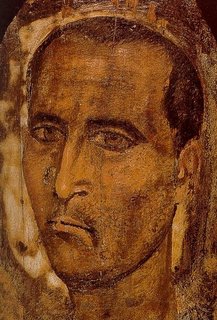From René Girard's Violence and the Sacred
The demands of regular employment are unfortunately keeping me from reading Girard as regularly as I would like, much less posting my favorite passages here. In any case, I'm proceeding as best I can, quoting here again from Chapter One. Before I do, I have to say that my own personal bugaboo, the the issue that keeps nagging at me when religion is regarded from a naturalist perspective, is how religion is supposed to deal with natural phenomena themselves. If religion is a natural phenomenon, how can it be expected to deal with more powerful natural phenomena? In short, how can a prayer (prayer that is merely an instance of natural phenomena) quell an earthquake? Girard takes up the issue in the first chapter:
My difficulty with the third paragraph is that while 'primitive' man may have seen the escalation of collective violence as something outside themselves, and for perfectly good reasons, we moderns do not. Are we wrong? Does Girard's theory rest on this distinction? It seems to me that it does.
More anon.
Inevitably the moment comes when violence can only be countered by more violence. Whether we fail or succeed in our effort to subdue it, the real victor is always violence itself. The mimetic attributes of violence are extraordinary - sometimes direct and positive, at other times indirect and negative. The more men strive to curb their violent impulses, the more these impulses seem to prosper. The very weapons used to combat violence are turned against their users. Violence is like a raging fire that feeds on the very objects intended to smother its flames.My difficulty with the end of the second paragraph is that although "we do not mean to endorse the theory that sees in the sacred a simple transfiguration of natural phenomena", many people do. In fact, isn't that exactly what people expect of the sacred? Not just another form of natural phenomena, but in fact some form of supernatural phenomena? And I'm not sure why this transfiguration would have to be 'simple'.
The metaphor of fire could well give way to metaphors of tempest, flood, earthquake. Like the plague, the resemblance violence bears to these natural cataclysms is not limited to the realm of poetic imagery. In acknowledging that fact, however, we do not mean to endorse the theory that sees in the sacred a simple transfiguration of natural phenomena.
The sacred consists of all those forces whose dominance over man increases or seems to increase in proportion to man's effort to master them. Tempests, forest fires, and plagues, among other phenomena, may be classified as sacred. Far outranking these, however, though in a far less obvious manner, stands human violence - violence seen as something exterior to man and henceforth as a part of all the other outside forces that threaten mankind. Violence is the heart and secret soul of the sacred. (31)
My difficulty with the third paragraph is that while 'primitive' man may have seen the escalation of collective violence as something outside themselves, and for perfectly good reasons, we moderns do not. Are we wrong? Does Girard's theory rest on this distinction? It seems to me that it does.
More anon.


0 Comments:
Post a Comment
<< Home